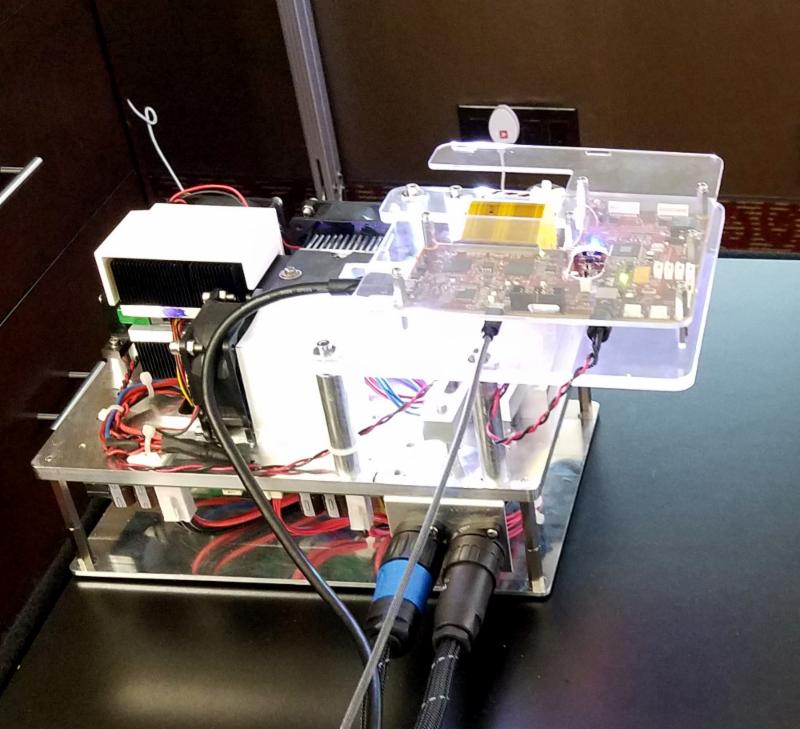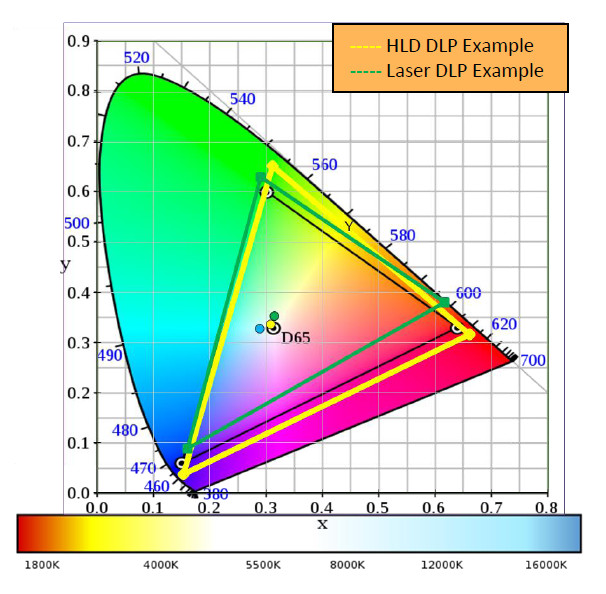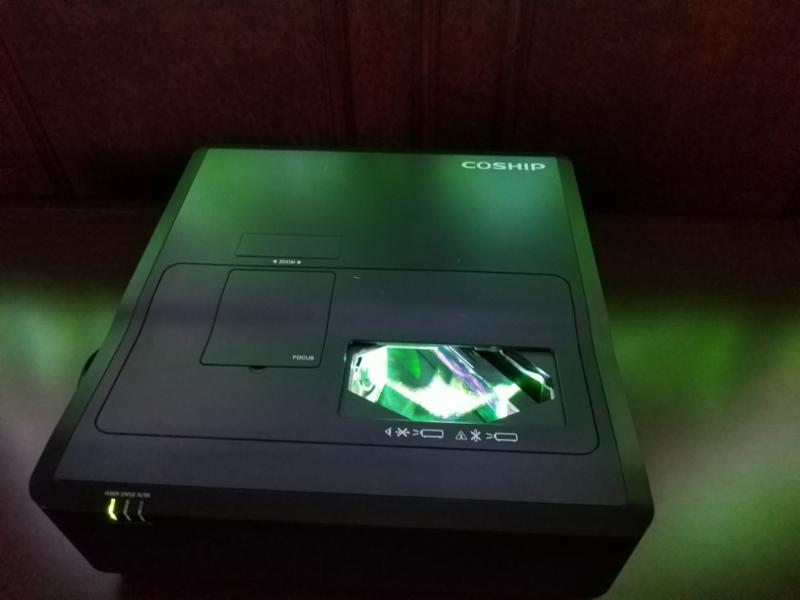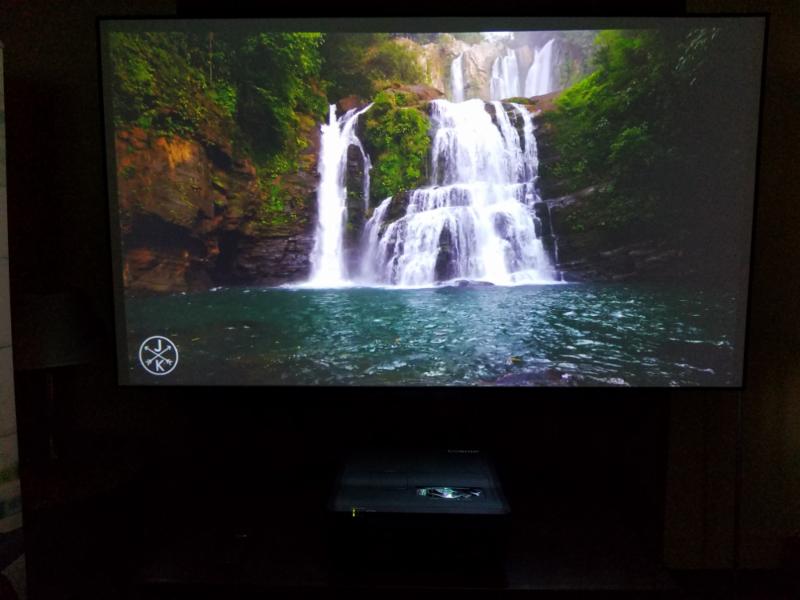In lower lumen projection solutions, there are two common illumination options. One is the laser phosphor solution which uses a blue laser and a yellow phosphor wheel to create RGB light and the other is a set of RGB LEDs.
The laser phosphor solution can achieve somewhat higher brightness levels than regular LEDs, but still below market desires, but will sacrifice color performance. Regular RGB LED solutions can achieve good color performance, but are strongly limited in brightness, often not achieving the market brightness needs. Philips’ ColorSpark HLD LED (High Lumen Density) solution can offer both – higher brightness and rich color performance. This makes for a very attractive value proposition to projector makers and their customers.
We met with Philips in their suite at CES 2018. There, we saw a demo that compared a standard off-the-shelf modified light engine using HLD technology, which also proofed the easy design-in of the ColorSpark HLD LED into optical engines vs. the same light engine but using a RGB LED illumination sources and one solution based on laser phosphor. The comparison is shown and explained in the video at https://youtu.be/aUUJxpMB6rk
In this article, we will provide some more details on the set up and our impressions. First, the modified ColorSpark HLD LED solution used the light engine from an off-the-shelf LED RGB projector, with the RGB LED stage removed and the new HLD sources inserted. The HLD stage consisted of red and blue LEDs from Osram (P2W) and a Gen 2 (303) green HLD module.
The green HLD module contains of a special rod of material that is pumped with blue LEDs and emits in the green. The advantage of the solution is the ability to reach higher luminance levels at the desired wavelengths with lower étendue than alternative green LED devices.
Philips offers a complete solid state solution, called ColorSpark HLD LED that includes the HLD LED module along with the red and blue LEDs. HLD modules are shown in the image below from CES 2018.
Each projector uses a non overlap (i.e. RGB color are only presented sequentially not simultaneously) 0.47″ TRP DMD, which is the most common solution for the pocket/pico market segment. All projectors were compared in the “Normal” mode. Prior to testing, luminance levels, white point and RGB primary chromaticity values were measured for three modes for three different projectors. These were an RGB LED projector, a modified RGB LED projector with the green LED replaced with a green HLD module, and a laser phosphor projector. Data from these three projectors is shown below.


|
Parameter
|
Mode
|
ANSI Lumens
|
White Point Chromaticity
|
% DCI-P3 coverage
|
|
HLD Prototype
|
Energy Saving
|
841
|
0.2882, 0.3544
|
|
|
Normal
|
1112
|
0.2905, 0.3220
|
95%
|
|
|
High
|
1488
|
0.2885, 0.3955
|
|
|
|
RGB LED projector
|
Energy Saving
|
401
|
0.2892, 0.3019
|
|
|
Normal
|
534
|
0.2892, 0.3080
|
95%
|
|
|
High
|
671
|
0.2825, 0.3140
|
|
|
|
LP Projector
|
cinema, minimum energy saving
|
642
|
0.2919, 0.3444
|
|
|
Standard, minimum energy saving
|
888
|
0.2747, 0.3278
|
<80%
|
|
|
Vivid, minimum energy saving
|
934
|
0.2725, 0.3251
|
|
Summary of Lumens, White Point Chromaticity Values and gamut Coverage for Three Projectors in Three Modes
In the demo, the HLD prototype is first compared to the RGB LED projector. The red and blue LEDs are common for both platforms, with the green LED swapped out for the green HLD module. The green HLD module has a slightly different chromaticity but offers much higher light output. This simultaneously allows the red and blue LEDs to be driven a bit harder leading to a more than 2X higher light output, depending upon the mode, with roughly similar color performance. However, the visual impact of the higher luminance is very noticeable, especially in a room with a lot of ambient illumination, which will tend to desaturate colors and reduce contrast.
While the above mentioned figures are from a lab-made mockup demo, Philips also foresees that actual measured numbers on brightness of the HLD LED could even be exceeded by professional OEMs.
It is also important to mention that Philips is bringing an upgrade of the Gen2 HLD LED version to the market, both for green and yellow HLD LED, which will be named 203+ and 303+. These solutions will be upgraded with new LEDs inside but also be étendue-designed to match 0.5″ DMDs, which are seen to be the future leading DMDs with 4K and 1080p resolutions, among others, in the screenless TV market. This upgrade simultaneously enables increased screen brightness and higher efficiency of the light source, thus less power consumption.
The second comparison Philips showed in their CES suite was to a common laser phosphor-based projector from a well known international brand. Laser phosphor solutions can be somewhat brighter, but they often trade off color performance to get there. Some laser phosphor-based projectors can do both, but now they sacrifice light/energy efficiency. This is not a good option for the mobile projector market.
The Laser projector has higher light output than the RGB LED projector, but it has weak performance in the red and green leading to an orangeish red, with light output still below market requests, said Philips. This weak color performance is evident from Figure 3 which shows the orange-shifted red primary and a desaturated blue primary.
Philips also pointed to another potential issue with the laser phosphor projector – blurring of fast moving objects. Such effects are not uncommon in LCD displays, but not so much in DLP projectors. The company theorizes that the 120-240Hz rotation rate of the phosphor wheel may have something to do with it as well as the slow extinction of the phosphor material. Gamers, a popular purchaser of these projectors, may find this artifact objectionable. HLD LED solutions modulate at 1KHz and do not show this effect.
While the demo above featured a green HLD LED module, Philips has also developed a yellow HLD module combined with a blue LED (P2W) which is in use today in projection solutions. For example, the 3LCD-based projector from Coship is called “H1 Nature TV” in China. This was introduced in September 2017 for ~ 25000 RMB (€3,200, $3,900). It offers 3600 lumens in bright mode and 2800 lumen in video mode. It looked quite good in the Philips suite at CES, showing great brightness in ambient environment, and good color performance.


Philips sees the “Screenless TV” market divided into two segments – stationary screenless TV and Pocket/Smart screenless TV.
Philips defines the stationary segment as a TV replacement segment where an ultrashort throw projector is hard and soft bundled with a screen and/or audio solution. So called “Laser TVs” from the likes of Hisense and Changhong are part of this category.
In the Pocket/smart screenless TV segment, the idea is to have a projector that does not replace the main home TV, but can be a secondary or portable TV. It contains smart TV functionality so it can be connected to a set top box or stream content from cloud-based services.

Futuresource Consulting tracks this screenless TV segment and now expects WW shipments of screenless TVs to surpass 0.5 million units in 2017 – a year on year growth rate of over 30%.
The consulting firm estimates that screenless TVs will take a little more than 30% of the worldwide home projection market in 2017 (this segment doesn’t include pico projectors with a footprint smaller than a smartphone). However, when focusing only on China, this figure will exceed 60% of the domestic market. The rest of the world meanwhile will remain below 10% representation from screenless TVs during 2017.
Clearly, the big opportunity is currently in China, but as Hisense emphasized at CES 2018, it plans to expand the category globally in 2018. And, LG has been successful as well with its line of projectors on a global scale. As a result, the 10% figure above may be a bit conservative.
Such growth is why Philips and many others are very excited about this market segment.

